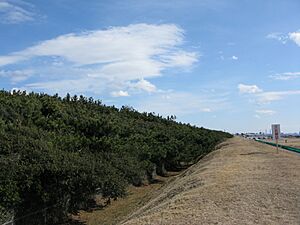Tsunami protection engineering facts for kids
Tsunami protection engineering is all about creating ways to keep people and places safe from the powerful waves of a tsunami. Engineers design special structures and plans to prevent or reduce the damage a tsunami can cause. The main goal is always to save lives and protect buildings.
Contents
How We Protect Against Tsunamis
Protecting against tsunamis involves different methods. These methods work together to create a strong defense. They can be natural or built by humans.
Building Strong Barriers
One important way to protect coastal areas is by building large walls called seawalls. These walls are placed in front of ports and cities. They act like a shield, blocking or weakening the tsunami waves before they reach the land. Seawalls are designed to be very strong to withstand the force of the ocean.
The Power of Trees
Nature can also help protect us. Planting many trees along the coastline is a very effective method. Trees, especially certain types like mangroves, have strong root systems. These roots can hold the soil in place and slow down tsunami waves. For example, in the 2004 tsunami, some villages in India had very few injuries or deaths. This was because they had planted many trees along their coast. The trees acted as a natural barrier, absorbing the wave's energy.
Learning from Past Events
Tsunami protection engineering also means learning from past disasters. Engineers try to predict and prevent problems that happened before. A good example is what happened at the Fukushima Daiichi Nuclear Power Plant in 2011. A huge tsunami hit the plant. The main power went out, and the backup generators also stopped working. This meant that cooling water could not reach the nuclear fuel. The fuel got too hot, which led to explosions and fires. It also caused a dangerous release of radiation.
Engineers now work to make sure such problems don't happen again. They design systems with many layers of backup power. They also make sure important equipment is placed high up, away from potential floodwaters. This helps keep critical systems running even during a major disaster.


